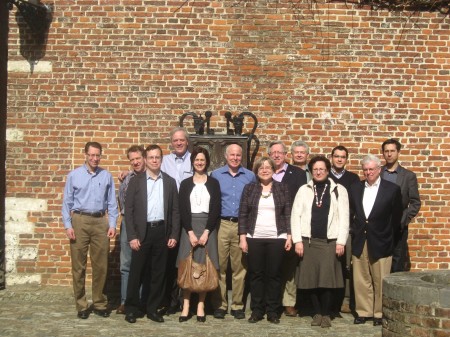 The Life Raft Group Research Team met in Leuven, Belgium last month to discuss progress to date, and formulate a plan on how to effectively move GIST research forward. Every member of the research team was in attendance, as well as guests Dr. Adrian Marino-Enriquez from Brigham & Women’s Hospital, Harvard University and Dr. Agnieszka Wozniak from the Catholic University in Leuven. LRG Executive Director, Norman Scherzer, Science Director, Jerry Call, Board Member, Jim Hughes and Executive Assistant, Lisa Pereira were also at the meeting. Research Team member Dr. Maria Debiec-Rychter of the Catholic University in Leuven was the extremely gracious host. A special thank you goes out to Genentech© for sponsoring the meeting.
The Life Raft Group Research Team met in Leuven, Belgium last month to discuss progress to date, and formulate a plan on how to effectively move GIST research forward. Every member of the research team was in attendance, as well as guests Dr. Adrian Marino-Enriquez from Brigham & Women’s Hospital, Harvard University and Dr. Agnieszka Wozniak from the Catholic University in Leuven. LRG Executive Director, Norman Scherzer, Science Director, Jerry Call, Board Member, Jim Hughes and Executive Assistant, Lisa Pereira were also at the meeting. Research Team member Dr. Maria Debiec-Rychter of the Catholic University in Leuven was the extremely gracious host. A special thank you goes out to Genentech© for sponsoring the meeting.
Before getting down to work, the group convened early to take in the beautiful city, including a walking tour of major historical sites. In addition to the famous late-Gothic Style Leuven Town Hall, everyone was particularly captivated by the restored Grand Beguinage which dates back to the 13th century. It was in one of these restored buildings that team meetings took place.
After the first full day of meetings, the group was joined at dinner by Catholic University officials and collaborators Raf Sciot (Director of Pathology Department), Patrick Schoffski (Director of General Medical Oncology Department), Erik Legius (Director of Center for Human Genetics), and Peter Vandenberghe (Director of Cancer Program).
The meeting wrapped up with renewed energy and a commitment from every researcher to continue this collaborative approach to finding a cure.
To wind down after two days of intense meetings, the group took a quick side trip to the fascinating city of Bruges, where they did their part to support local chocolatiers, taking home bags of goodies to share!
Below is a summary of some of the teams’ progress in the last year, prepared by LRG researchers and staff. More detailed updates will be coming in the following issue.
SUMMARY: Life Raft Group Research Team Meeting Progress Report
D-Day Project, March 11-13, 2012
In 2006, the Life Raft Group initiated a strategic research plan – Pathway to a Cure –that emphasized cooperation, coordination and accountability and brought together ten of the finest GIST researchers in the world. Its focus was on identifying projects with the greatest chance of successful outcomes. In 2010, a Dutch GIST patient named Jeroen Pit, struggling to overcome treatment resistance, was investigating the best way to donate to GIST research. After consulting several leading GIST researchers, he decided that the LRG research team gave him the best chance for finding a cure. The funds he raised, when added to funds already raised by the LRG, have served as a catalyst for the rapid identification and validation of relevant treatment strategies. Though Jeroen passed away in early 2012, his legacy and tenacity continues on in the work the research team is doing for all the patients like him, present and future.
Project D-Day is focused on four areas: Sequencing of the GIST genome, Gene Knockdown studies, or screens that examine pathways essential for GIST cell survival, Drug Screening of GIST cells against large libraries of drug compounds, and Validation studies of important candidates from the first three areas that would allow a timely translation into clinical trials. Some highlights of recent accomplishments in these areas are as follows:
Sequencing
- Performed the largest known analysis of the GIST genome, identifying 214 mutations predicted to have a biological effect, and validated them to exclude false positives.
- Categorized mutations by function to better understand their relevance in GIST.
Gene Knockdown
- Performed RNA screens for two imatinib-sensitive cell lines and are currently doing so on a third.
- Ranked 11,000 genes in several GIST cell lines in order of their functional relevance for GIST.
- Identified a component of a key pathway in GIST that is five times more specific than some previously tested targets and which may help successfully overcome secondary resistance, the most common cause of treatment failure.
- Identified promising therapeutic targets that may be critical for GIST cell survival.
Drug Screening
- 127 compounds have been tested, with validation of existing GIST drugs acting as a reference.
- 4 drugs have been identified as being of possible therapeutic value.
- Identified several traditional chemotherapies that have in-vitro activity against GIST.
Validation
- Found that almost every GIST patient has changes in genes that affect the cell cycle and result in advanced GIST. This could point toward common genetic “events” that may yield a treatment strategy.
- Continued promising work on inhibitors, a therapeutic antibody, and tumor cell death.
- Analyzed how knockdown and sequencing screens influence each other and converge.



